| Article ID | Journal | Published Year | Pages | File Type |
|---|---|---|---|---|
| 1960188 | Biophysical Journal | 2006 | 14 Pages |
Potassium channel activation regulates cellular excitability in cells such as neurons and heart. Ion channel activity relies on a switching mechanism between two conformations, the open and closed states, known as gating. It has been suggested that potassium channels are gated via a pivoted mechanism of the pore-lining helix. Our analysis suggests that hinging occurs at the residue immediately preceding the central glycine of the inner helix. Furthermore, we show that the highly conserved central glycine is necessary to prevent constraining interactions with critical residues in its vicinity, including those located in the selectivity filter. We show that such interactions can impair channel function, and that upon their removal channel activity can be restored.
